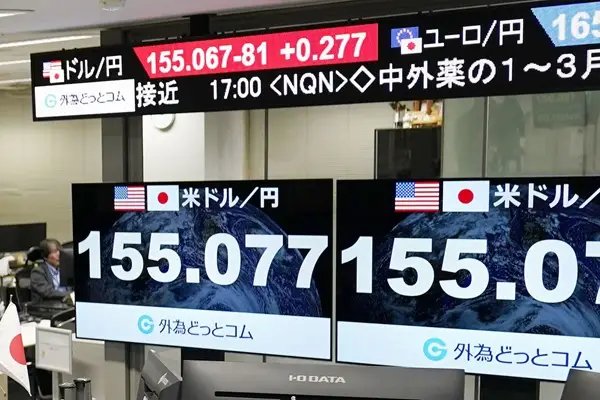The recent decline of the USD/JPY pair toward the 152.86 level was not merely a technical move in the currency market, but rather a direct reflection of a deeper shift in global monetary policy dynamics, where the U.S. Federal Reserve’s cautious tone intersects with growing signs of stability in the Japanese economy.
From my economic perspective, monitoring the behaviour of major currencies at this stage reveals that we are witnessing a transitional phase in the U.S. dollar’s trajectory, alongside a gradual return of the Japanese yen as a safe-haven currency supported by strong domestic economic data and the Bank of Japan’s carefully calibrated monetary policy.
The recent weakness in the U.S. dollar stems from several intertwined factors, most notably the cautious tone adopted by the Federal Reserve.
After a modest 25-basis-point rate cut, Fed Chair Jerome Powell made it clear that further easing is not a given — a statement that sent mixed signals to the markets.
On one hand, it reflects the Fed’s concern about slowing growth, and on the other, it underscores its unwillingness to jeopardize the dollar’s strength amid inflation that remains above target.
These messages prompted investors to reprice their expectations, reducing the odds of a rate cut in December and, in turn, curbing risk appetite toward the greenback — especially amid the ongoing uncertainty surrounding the prolonged U.S. government shutdown and the delay in releasing key economic data.
In contrast, the Japanese economy has shown notable resilience, supported by robust data in both the labour and services sectors. Cash earnings rose by 1.9% year-on-year, reflecting improved household purchasing power and labour market stability. Meanwhile, the Jibun Bank Services PMI exceeded expectations at 53.1, confirming continued expansion in this vital sector. These figures are not mere short-term indicators; they reflect a structural improvement in economic performance, reinforcing investor confidence in Japan’s ability to overcome the stagflation phase it faced for years. In my view, these developments provide the yen with solid and sustainable support, rather than temporary strength as in previous cycles.
It is also important to note that although the Bank of Japan kept its interest rate at 0.50%, the minutes of its latest policy meeting revealed a gradual inclination toward policy normalization. While policymakers reiterated that real interest rates would remain extremely low, the overall tone suggested a growing readiness to act cautiously should growth and inflation forecasts materialize. In my opinion, this balance between patience and prudence is one of the key reasons behind the yen’s current stability, as it reassures investors that the BoJ will neither rush rate hikes that could hinder growth nor delay adjustments that could leave the yen overly weak. This balanced stance bolsters market confidence and supports the yen’s appeal as a relatively stable reserve currency.
On the American side, the Fed’s indecision places the dollar in a complicated position. While the central bank does not want to appear overly hawkish and risk slowing growth, it also cannot reverse its policy stance too quickly for fear of reigniting inflationary pressures. This delicate balance makes the dollar highly sensitive to incoming data. In my view, the lack of official economic reports due to the prolonged government shutdown adds fragility to the situation, as markets are now relying on private-sector indicators such as ADP and ISM — useful, but not comprehensive. Hence, any negative surprises in upcoming data could accelerate the dollar’s decline, especially against currencies with stronger domestic fundamentals, like the yen.
From my perspective, the USD/JPY drop to 152.86 does not appear to mark the end of the move but rather the start of a deeper correction that could extend toward 151.00 or even 149.00 if current fundamentals persist. The decline is driven not only by dollar weakness but also by growing demand for the yen as a safe-haven currency amid rising geopolitical and financial risks. As global investors grow increasingly concerned about a U.S. economic slowdown and the lingering impact of the government shutdown, it is natural to see capital shifting toward safer assets — a trend reflected in the concurrent rise in demand for both the yen and gold.
Looking at the medium term, I believe the yen’s path will remain supported by strong fundamentals, while the Bank of Japan now has greater room for cautious maneuvering to absorb external shocks without losing control over interest rates or inflation. In contrast, the U.S. dollar will remain hostage to domestic political developments and fluctuating expectations regarding Fed policy. If clarity continues to elude the U.S. outlook, we may enter a period of heightened market volatility in which the yen emerges as the primary beneficiary, driven by the global appetite for safety and stability.
Strategically, I see this phase as an opportunity to reassess the traditional view of the dollar-yen relationship. After years of being considered a low-yield funding currency, the yen is now being treated as a currency with more balanced economic fundamentals. If Japan continues to deliver positive indicators in wages, output, and services, the likelihood of the yen returning to pre-ultra-easing levels appears more realistic than ever. The dollar, meanwhile, will need strong growth data and a clear decline in inflation before it can regain its previous momentum.
Ultimately, the recent decline in the USD/JPY pair reflects a deeper change in global market sentiment. The dollar has lost some of its shine as an absolute haven amid rising domestic uncertainty, while the yen has begun to reclaim its role as a stability anchor supported by a more coherent economic environment. From my standpoint, the overall trend remains in favor of the yen in the near term, with limited prospects for a dollar rebound until U.S. policy direction becomes clearer in the coming months. This transitional phase demonstrates that markets move not only on numbers but also on expectations and confidence — two factors Japan has recently managed to restore with remarkable success.







